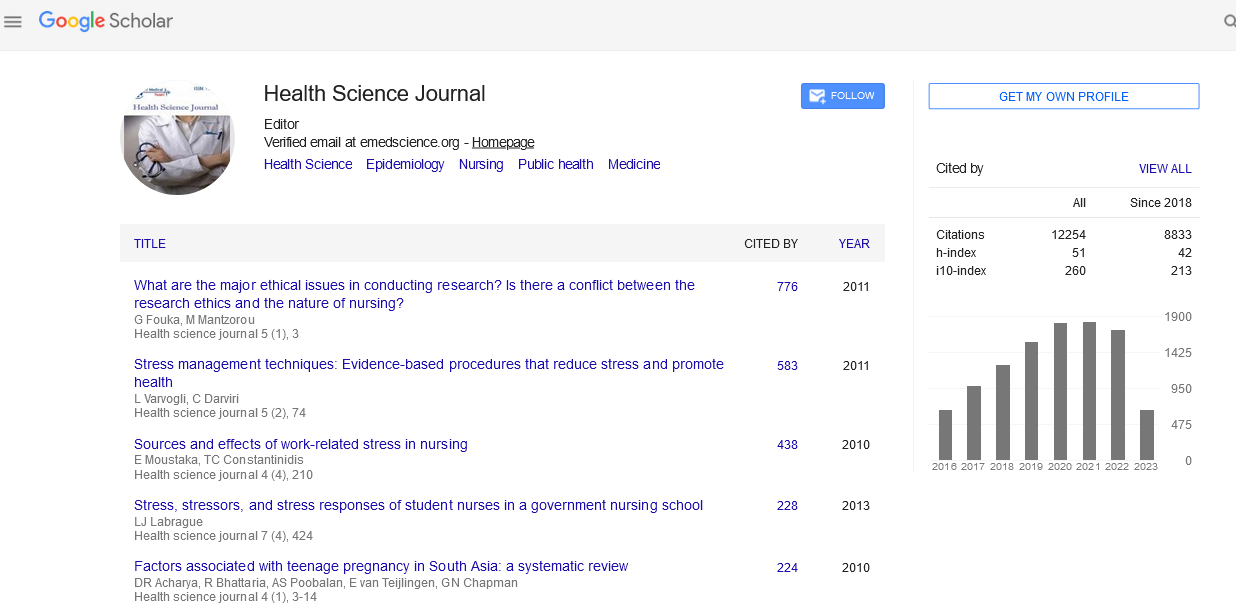Editorial - (2025) Volume 19, Issue 1
Exploring the Efficacy of Telemedicine in Managing Chronic Diseases in Remote Indigenous Communities: A Randomized Trial
Haruki Murakami*
Department of Health Science, Queen's University, Canada
*Correspondence:
Haruki Murakami, Department of Health Science, Queen's University,
Canada,
Email:
Received: 01-Jan-2025, Manuscript No. Iphsj-25-15515;
Editor assigned: 04-Jan-2025, Pre QC No. Iphsj-25-15515 (PQ);
Reviewed: 16-Jan-2025, QC No. Iphsj-25-15515;
Revised: 21-Jan-2025, Manuscript No. Iphsj-25-15515 (R);
Published:
30-Jan-2025, DOI: 10.36648/1791-809X.19.1.1216
Introduction
Chronic diseases, such as diabetes, hypertension, and cardiovascular diseases, present a major health burden globally, particularly in underserved and remote populations. Indigenous communities, especially those in geographically isolated areas [1], often face significant barriers in accessing healthcare services. These challenges are exacerbated by factors such as limited healthcare infrastructure, cultural and language differences, and socioeconomic disparities. As a result, Indigenous populations are at higher risk of experiencing poor health outcomes, including the complications associated with chronic diseases. One potential solution to mitigate these challenges is the use of telemedicine, which leverages technology to provide remote medical consultations, monitoring, and management. This article examines a randomized trial designed to explore the efficacy of telemedicine in managing chronic diseases in remote Indigenous communities, focusing on its impact on patient outcomes, healthcare accessibility, and overall care delivery [2].
Background and Context
In remote Indigenous communities, access to healthcare is often limited by geographic isolation, with many communities located far from urban centers where healthcare facilities are concentrated. These areas frequently suffer from a shortage of healthcare professionals, particularly specialists, leading to delays in diagnosis, treatment, and ongoing management of chronic conditions [3]. Traditional healthcare delivery models, which rely heavily on in-person consultations, may not be feasible or efficient in these regions. Telemedicine offers a promising alternative by enabling healthcare providers to remotely monitor patients, conduct virtual consultations, and provide education and support through digital platforms. However, the effectiveness of telemedicine in managing chronic diseases in remote Indigenous communities remains an area of active research. Chronic diseases, including type 2 diabetes [4], hypertension, and respiratory conditions, are particularly prevalent in Indigenous populations, often due to a combination of genetic, environmental, and lifestyle factors. These diseases require ongoing management and monitoring to prevent complications such as cardiovascular events, renal failure, and vision impairment. Despite the high burden of chronic diseases in Indigenous communities, many individuals do not receive regular medical care or effective disease management due to the aforementioned barriers. Telemedicine, by bridging the distance between patients and healthcare providers, offers the potential to improve chronic disease management in these settings [5].
Study Design and Methodology
The randomized trial was designed to assess the efficacy of telemedicine interventions in managing chronic diseases in remote Indigenous communities. The study involved participants from several Indigenous communities located in geographically isolated regions [6]. Participants were randomly assigned to either the intervention group, which received telemedicine-based care, or the control group, which continued to receive standard in-person care from local healthcare providers. The primary aim of the study was to evaluate the impact of telemedicine on key health outcomes, including disease control, quality of life, healthcare utilization, and patient satisfaction. The telemedicine intervention involved a combination of virtual consultations, remote monitoring of vital signs (e.g., blood pressure, blood glucose levels), and regular follow-up with healthcare providers via video calls or phone consultations. Healthcare providers, including general practitioners, nurses, and specialists, were trained to use telemedicine platforms to assess patients' health, provide guidance on disease management, and offer tailored treatment plans. Patients in the intervention group were equipped with digital devices to monitor their health metrics, which were transmitted to healthcare providers in real time. In addition, the intervention included culturally sensitive health education to ensure that the care provided was relevant and respectful of Indigenous values and practices. The control group continued to receive standard care, which typically involved periodic in-person visits to local healthcare centers or travel to larger urban hospitals for specialist consultations. Due to the remoteness of the communities, travel to these facilities often posed significant challenges, including long travel times, transportation costs, and logistical barriers. Therefore, the control group had limited access to specialized care and relied heavily on local healthcare providers with limited resources.
Key Outcomes and Results
The study found that the use of telemedicine significantly improved chronic disease management in the intervention group compared to the control group. One of the most notable findings was the improvement in disease control among participants with diabetes and hypertension. Remote monitoring of blood glucose and blood pressure allowed healthcare providers to intervene earlier and more frequently, adjusting treatment plans as needed to maintain optimal disease control. This proactive approach to disease management resulted in better overall health outcomes, including a reduction in the number of hospitalizations and emergency visits for complications related to chronic diseases. Furthermore, the intervention group reported higher levels of satisfaction with their healthcare experience. Participants appreciated the convenience of receiving care remotely, as it reduced the need for long and often difficult travel to access medical services. The ability to receive care in a culturally sensitive manner, where healthcare providers were trained to understand and respect Indigenous customs and language, also contributed to the positive feedback. Many patients expressed a sense of empowerment and autonomy in managing their health, as telemedicine provided them with regular, personalized contact with healthcare professionals without the burden of travel. Another important outcome was the reduction in healthcare disparities between remote Indigenous communities and urban centers. The telemedicine intervention helped bridge the gap in access to specialized care, ensuring that patients with chronic conditions received timely assessments and management from healthcare providers with expertise in their conditions. The trial also revealed that telemedicine was associated with a reduction in the overall cost of healthcare, as it minimized the need for travel and in-person consultations. This has important implications for the sustainability of healthcare delivery in remote Indigenous communities, as telemedicine offers a cost-effective solution to overcome geographical and logistical barriers. While the telemedicine intervention showed promising results in improving chronic disease management, the study also highlighted several challenges. Technical issues, such as connectivity problems and limited access to reliable internet, were significant barriers to effective telemedicine use in some communities. Additionally, some participants faced difficulties in using the technology, particularly older individuals or those with limited digital literacy. Despite these challenges, the overall benefits of telemedicine in improving health outcomes and patient satisfaction were evident, and these issues were addressed through ongoing training and support for both patients and healthcare providers.
Implications for Healthcare Delivery
The results of this randomized trial have important implications for healthcare delivery in remote Indigenous communities. Telemedicine has the potential to revolutionize chronic disease management by offering a more accessible, efficient, and culturally appropriate alternative to traditional healthcare models. By providing remote consultations and continuous monitoring, telemedicine can help ensure that patients with chronic diseases receive timely and personalized care, reducing the risk of complications and improving long-term health outcomes. However, the success of telemedicine interventions in these communities depends on addressing several key factors, including improving technological infrastructure, ensuring digital literacy, and providing culturally competent care. To fully realize the benefits of telemedicine, healthcare systems must invest in reliable internet connectivity and train healthcare providers to use telemedicine platforms effectively. Moreover, telemedicine programs must be designed with input from Indigenous communities to ensure that they meet the unique needs and preferences of the population.
Conclusion
This randomized trial demonstrates the efficacy of telemedicine in managing chronic diseases in remote Indigenous communities. The use of telemedicine improved disease control, patient satisfaction, and healthcare access, while also reducing healthcare costs. While technical challenges and digital literacy remain important considerations, the potential of telemedicine to transform healthcare delivery in underserved populations is clear. As healthcare systems continue to grapple with the challenges of providing care in remote areas, telemedicine offers a promising solution to ensure that individuals in these communities receive the care they need, when they need it, and in a manner that respects their cultural values. Future research and continued investment in telemedicine infrastructure will be crucial in expanding its reach and effectiveness in managing chronic diseases in Indigenous and other underserved populations.
References
- Harris JE, Eng JJ (2006) Individuals with the dominant hand affected following stroke demonstrate less impairment than those with the no dominant hand affected. Neuro rehabilitation and neural repair 20: 380-389.
Google Scholar, Crossref
- Hitchhiker’s Thumb (Distal Hyperextensibility): Symptoms, Causes & Outlook. (n.d.). Retrieved December 8.
Google Scholar
- Inzinger M, Massone C, Arzberger E, Hofmann-Wellenhof R (2013) Hair repigmentation in melanoma. The Lancet 382: 1224.
Google Scholar, Crossref
- Bakan P, Dibb G, Reed P (1973) Handedness and birth stress. Neuropsychologia 11: 363-366.
Indexed at, Google Scholar, Crossref
- Boumba V, Ziavrou K, Vougiouklakis T (2006) Hair as a biological indicator of drug use, drug abuse or chronic exposure to environmental toxicants. Int J Tox 25: 143-163.
Indexed at, Google Scholar, Crossref
- Cappella A, Bertoglio B, Di Maso M, Mazzarelli D, Affatato L et al.(2022) Sexual Dimorphism of Cranial Morphological Traits in an Italian Sample: A Population-Specific Logistic Regression Model for Predicting Sex. Biology 11: 1202.
Google Scholar, Crossref
Citation: Murakami H (2024) Exploring the Efficacy of Telemedicine in Managing Chronic Diseases in Remote Indigenous Communities a Randomized Trial. Health Sci J. Vol. 19 No. 1: 1216.





